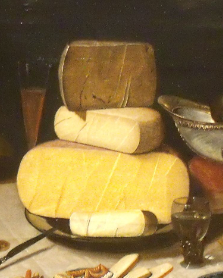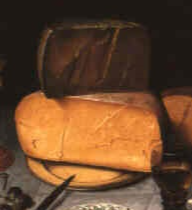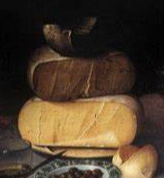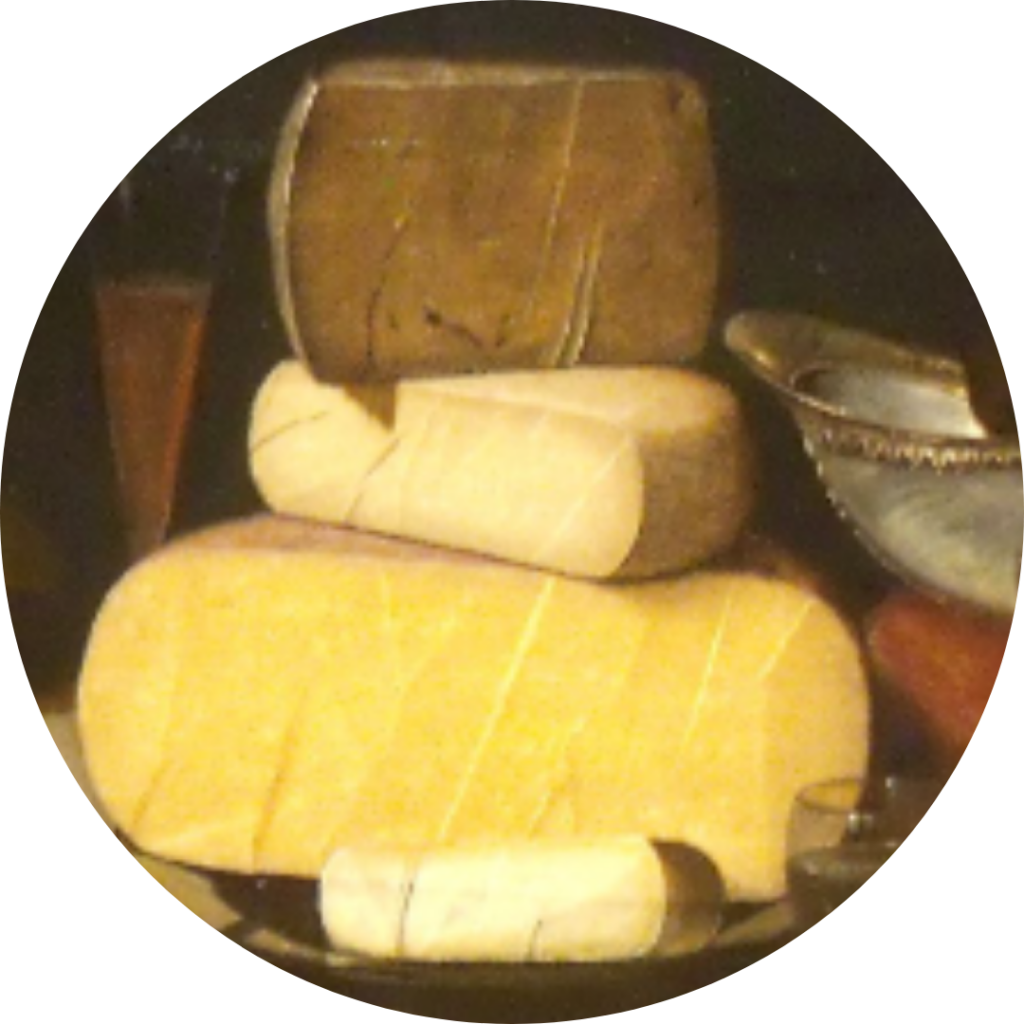Texelse Schapenkaas
I was at a posh dinner for The Worshipful Company of Distillers at the Mansion House in London, famously home of the Lord Mayor and less famously home to The Harold Samuel Collection of Dutch and Flemish 17th century paintings. Amongst those paintings was some beautiful still lifes by Floris Van Schooten of – yes you’ve guessed it – Dutch cheese.
The difference between Gouda and Edam wasn’t set in stone in those days. Cheeses were judged on a wheel by wheel basis on the reputations of the their makers and famous markets the cheeses were found at.

But what got my attention was the repeated representation of very dark cheeses.
What where they? Why were they dark? and can you get them today?
The cheese are dark, almost coffee coloured, generallly smaller and they look hard.
Cheesemonger friends started saying they were variants of the whey cheeses of Scandinavia, such as gjetost, fudge or marmite coloured caramelised whey and cream cheeses. But I didn’t think so, the shape and colour is wrong. Then Andrew Green, IFA and fine food caterer with excellent cheese knowledge, passed on the nugget that Texel cheese used to be coloured with Extract of Sheep Poo.


Is this
Texelse Schapenkaas?
(pronounce that after 4 Jenever)
Texelse Schapenkaas, or Texel sheep’s cheese, is a unique product with a long and rich history tied to the island of Texel in the Netherlands. Famous for its lush green pastures, the island of Texel provides an ideal environment for sheep farming.
Cheese made from the milk of Texel sheep became a regional delicacy, known for its distinctive flavor, texture, and—historically—its unusual ingredient: boiled sheep’s poo.

The Origin of Texelse Schapenkaas
Texelse Schapenkaas dates back to the 16th and 17th centuries when ships from all over the world docked at Texel’s ports. Locals made cheese from the high quality milk from Texel’s lush pastures, prized both for its taste and for its ability to be stored for long periods.
What set Texelse Schapenkaas apart from other cheeses was the peculiar practice of adding an ingredient that would shock modern consumers: sheep’s poo. This wasn’t just any sheep’s poo, though. It was boiled to extract a juice that would then be added to the cheese. This juice played a key role in giving the cheese its signature characteristics: a sharp flavor, a greenish hue, and extended shelf life.

The Role of Sheep’s Dung in Cheesemaking
The use of sheep’s dung in Texelse Schapenkaas may sound unsanitary by today’s standards, but back in the 16th and 17th centuries, it was a practical solution for preserving cheese. At the time, refrigeration didn’t exist, and cheesemakers had to rely on natural methods to ensure their product stayed fresh. The juice from boiled sheep’s dung contained natural preservatives, which helped inhibit the growth of harmful bacteria. It also added a layer of fermentation that contributed to the cheese’s sharp, tangy flavor.

The greenish tint that the cheese developed from the dung juice wasn’t just a visual curiosity; it became a trademark of the cheese. The distinct taste—sharp and earthy—was appreciated by locals and traders alike, making Texelse Schapenkaas a sought-after product beyond Texel’s shores.
The End of a Smelly Tradition
The practice of adding boiled sheep’s dung to Texelse Schapenkaas continued for centuries, but by the 1930s, modern hygiene standards and advances in food preservation made this method obsolete. The rise of pasteurization and refrigeration meant that cheesemakers no longer needed to rely on such unorthodox techniques to keep their products fresh.
The practice of adding boiled sheep’s dung to Texelse Schapenkaas continued for centuries, but by the 1930s, modern hygiene standards and advances in food preservation made this method obsolete. The rise of pasteurization and refrigeration meant that cheesemakers no longer needed to rely on such unorthodox techniques to keep their products fresh. As a result, the dung juice was phased out, and the production of Texelse Schapenkaas evolved to focus solely on the quality of the milk and traditional cheesemaking methods.
Though the cheese lost its green tint and sharp, pungent flavor associated with the sheep’s dung, Texelse Schapenkaas is still produced today, albeit without the controversial ingredient.
The Poo-Less Texelse Schapenkaas Today
Today, Texelse Schapenkaas remains a beloved product, though the modern version bears little resemblance to the sheep dung-infused cheese of centuries past. The cheese is often made with raw milk to preserve the natural flavors of the island’s vegetation, which influence the taste of the milk. It has a smooth, slightly crumbly texture and a flavor that is mildly tangy with a subtle nuttiness, reflecting the quality of the sheep’s milk rather than any external additives.

Find out more here Texel sheep’s cheese | VVV Texel and here Texel Sheep Cheese – Presìdi Slow Food – Slow Food Foundation (fondazioneslowfood.com)
So is the Mansion House putting up pictures of Poo Cheese?
Did Floris Van Schooten, buried 14 November 1656, choose his subject matter to lock in poo cheese for posterity, or are his dark cheeses of the 17th Century still a mystery?
Comment somewhere and have your point of view.



